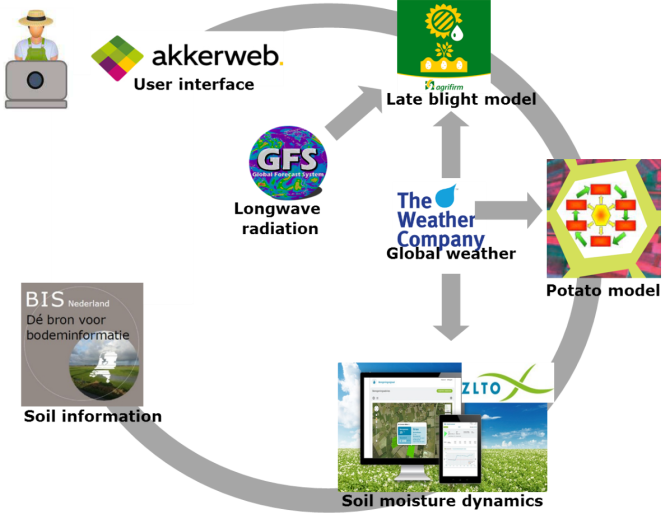
Use case
Recommendations for the control of late blight in potato
Precision agriculture (PA) aims to apply the right material and the right application rate, at the right time and at the right place, using the right method. This is difficult and therefore practitioners of PA need recommendations based on data and models to help them make the right decisions. In the case of late blight, recommendations can help to prevent over-application of fungicides (which is costly and harms the environment unnecessarily) as well as under-application of fungicides (which would lead to infection of the crop with late blight and consequent financial loss).
Problem statement / motivation
In this project we connect several sources of data and several models in order to make a recommendation for the application of fungicide to protect potatoes from infection with late blight (Phytophthora infestans L.).
Solution / approach
This project connects data and models from several scientific disciplines: soil science, climatology, agronomy and phytopathology, in order to generate practical recommendations for farmers. We use web services
as the primary tool to connect data sources and models (see Figure). The final step, a real-time link between soil moisture model and potato growth model will be realized in the future. We have encountered no major problems: connecting data and models using web services works very well.
Figure:
Connecting data sources and models to control late blight in potato

1: Soil data from WEnr are made available through a web service. 2: Weather data (temperature, precipitation, irradiation) are sourced from a global weather data provider, augmented with evapotranspiration calculated with the Dutch-standard Makkink formula, and stored on the servers of Akkerweb; from there, they are made available through a web service. 3: Longwave radiation calculated by the Global Forecast System (GFS) of the US National Weather Service (open-source) is retrieved. 4: The soil moisture dynamics model of Wageningen Livestock Research has been made accessible through a web service; this model uses soil data (1) and weather data (2). 5: The potato growth model of WPR has been modified so that it can take soil moisture data from (4) as input. 6: The late blight model uses data from the growth model (5) as input; the late blight model has also been modified to calculate leaf wetness (important for infection risk) by using longwave radiation (3) as an additional input.
(Expected) impact of the approach
Our approach will provide a practical way
to connect products of data providers and scientists from very different
backgrounds. In the case of recommendations for control of late blight highlighted
here, the approach will lead to a reduction in the cost of production and a
reduction of environmental impact.
The used methods are very general,
supported by most IT environments and languages, and can therefore be used by
others easily.
Next steps
The chosen approach works well for the current question. For other problems adaptations may be needed.
The web services we have implemented could be improved by having them provide meta information about their interface (input and output). This can be done best with one or more ontologies. There are many ongoing efforts to create ontologies for the plant domain, but sadly none of them has yet reached a sufficient level of stability and acceptance.
Facts & Figures
In the Netherlands, 10-16 fungicide applications are made per year; the associated cost of chemicals is M€ 61.1 per year (Haverkort et al., 2008). Using the late blight app this can be reduced to an average of 11 applications per year, i.e. 16% reduction in cost and in environmental impact.
Literature
Haverkort AJ, Boonekamp PJ, Hutten R et al. (2008) Societal costs of late blight in potato and prospects of durable resistance through cisgenic modification. Potato Research 51, 47-57.
More
information
Frits van Evert
+31 317 480 573